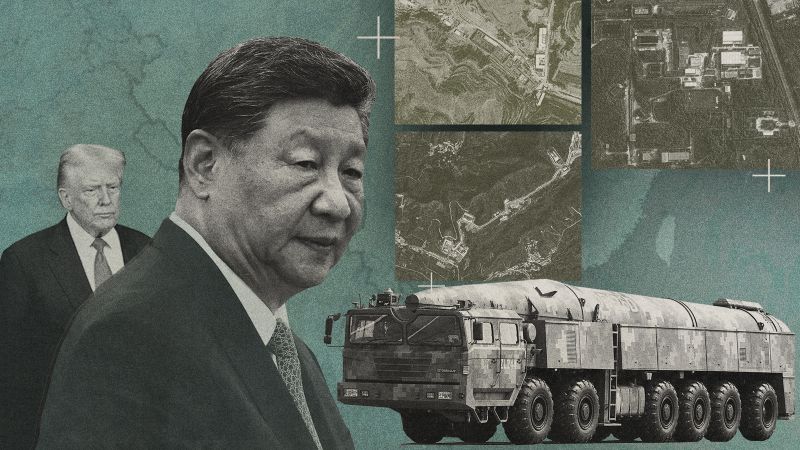Copyright Cable News Network

China has undertaken a massive expansion of sites linked to missile production since 2020, bolstering its ability to potentially deter the US military and assert its dominance in the region, a new CNN analysis of satellite images, maps and government notices reveals. The historic build-up stands in stark contrast to the United States’ own supply struggles. More than 60% of 136 facilities connected to missile production or the Chinese military’s rocket force, which controls China’s nuclear arsenal, showed signs of expansion in satellite images. The sites, which include factories as well as research and testing centers, have expanded by more than 21 million square feet (over 2 million square meters) of constructed floor space between early 2020 and late 2025. New towers, bunkers and berms consistent with weapons development have cropped up in satellite imagery of these growing sites. In some cases, missile parts can even be seen in the images. “This is China positioning itself as a global superpower. We’re in the initial phases of a new arms race,” said William Alberque, a senior adjunct fellow at the Pacific Forum and former NATO director of arms control. “China is already sprinting and they’re preparing for a marathon.” The data paints a picture of an urgent drive to develop capacity for new and more sophisticated missiles. Several of the production facilities that CNN analyzed have swiftly replaced villages and farmland, growing by tens of thousands of square feet in the past five years. CNN identified the sites – including over a dozen previously unreported facilities – by examining publicly available information on China’s two major state-owned defense contractors and their subsidiaries, and then cross-checking the findings with geospatial analysis. Since coming to power in 2012, Chinese leader Xi Jinping has poured billions of dollars into buying and upgrading military equipment, as part of a clearly defined ambition to rapidly transform the country’s armed services, known as the People’s Liberation Army (PLA), into a “world-class” fighting force. Xi has also built up the PLA Rocket Force (PLARF), an elite branch overseeing China’s fast-expanding arsenal of nuclear and ballistic missiles. He has described the force as a “core of strategic deterrence, a strategic buttress to the country’s position as a major power, and a cornerstone on which to build national security.” China’s missile production facilities supply nearly all branches of its military, which is the largest armed forces in the world with over 2 million active personnel. CNN has requested comment from China’s defense ministry on the findings. US President Donald Trump took a whirlwind tour of East Asia last week, meeting with leaders including Xi. Trade discussions dominated those meetings, but there were signs of growing tensions over Beijing’s surging conventional and nuclear arsenal. In the run-up to the talks with the Chinese president, Trump instructed the Pentagon to resume nuclear testing on an “equal basis” with China and Russia, ushering in a major shift in decades-long US policy. Beijing and Moscow have not conducted nuclear explosive tests in over 25 years. But Washington has been watching closely as both countries continue to develop and test advanced weapons capable of delivering nuclear warheads. China, meanwhile, is growing its nuclear weapon stockpile faster than any other nation, increasing its arsenal by about 100 new warheads annually since 2023, according to the Stockholm International Peace Research Institute (SIPRI) in June, though its total number remains far behind that of the US and Russia that together account for 90% of the world’s arsenal, according to the Union of Concerned Scientists. Plans for potential conflict with Taiwan Weapons experts say that the projectiles produced by expanded facilities examined by CNN would be a key component of any possible attempted Chinese military takeover of Taiwan, the self-ruled island that Beijing claims as part of its territory. The missiles are central to its strategy to keep the US Navy at arm’s length in such an event, with a zone off the coast of China which experts call “the anti-access denial bubble,” aiming to potentially discourage Washington from coming to Taiwan’s aid. The PLA wants “to set the conditions for the invasion of Taiwan,” said Decker Eveleth, an associate research analyst at the non-profit national security group CNA and an expert on China’s missile forces. “So that’s shooting at ports, shooting at helicopter bases, shooting at supply bases… shooting at anything that can theoretically let you bring support to Taiwan. “They want to destroy things in theater and keep everything else out.” CNN identified 99 sites linked to missile manufacturing and found that 65 of these facilities have expanded with constructed floor space that experts say could have an exponential impact on the scale of China’s production. CNN also analyzed 37 bases belonging to the Rocket Force and found that 22 of these have expanded over the last five years. China boosts offensive weapons as US battles supply issues In December 2024, the Pentagon estimated that China’s rocket force had boosted its missile supply by 50% in the preceding four years. CNN’s analysis of the infrastructure to produce those weapons suggests that Chinese efforts have continued unabated and provides further insight into the sites making those rockets. Earlier this year, China approved an increase of 7.2% in its defense budget, bringing the overall spending to approximately $245 billion. This marks the fourth consecutive year of more than 7% growth in military spending, though many experts say China’s real expenditure is likely much higher than the official figure. China’s apparent surge in missile production comes as the US expends sophisticated defense systems in Ukraine and Israel, causing some ammunition shortages and sparking debate in Washington about how and where to deploy its high-end weapons. In July, CNN found that the US had burned through about 25% of its Terminal High Altitude Area Defense (THAAD) missile interceptors while defending Israel against Iranian ballistic missile strikes during June’s 12-day war. The US government has since expanded a previous contract by more than $2 billion to defense company Lockheed Martin to bolster THAAD production. But these interceptors – which cost roughly $12.7 million per unit according to the 2025 Missile Defense Agency budget – are also time-consuming to build. The THAAD system was initially deployed inside the US and in the Asia-Pacific region, and it is considered a key part of the US deterrence strategy against China. While it remains capable of shooting down China’s missiles, experts warn that the Pentagon’s supply issues, coupled with Beijing’s drive for more advanced missiles, pose a growing threat to US interests. Asked for comment on CNN’s findings, the Pentagon said it would not “speak to matters of intelligence.” CNN’s findings also suggest that China’s missile production spiked in response to Russia’s full-scale invasion of Ukraine in 2022, considered a watershed moment in global security. Beijing nearly doubled the rate of expansion at missile production sites in the two years that followed the onset of the war, according to CNN’s satellite imagery analysis of constructed floorspace. “They’re watching Ukraine incredibly closely,” Alberque said. “They’re now watching real-life combat action between two very capable forces with the most modern technologies going toe to toe and they’re taking copious notes.” The PLA, which has not engaged in combat since a brief conflict with Vietnam in 1979, draws lessons from ongoing conflicts. Russia’s aerial assault on Ukraine has shown that the most surefire way to strike sensitive targets is by overwhelming sophisticated Western air defense systems with cheaper munitions such as drones so that more powerful ballistic missiles can hit their targets, experts say. That requires ramping up the production of both cheap and expensive missiles. China previously thought it might need 5,000 or 10,000 missiles to defeat Taiwan, according to Alberque. After Russia’s invasion of Ukraine, Beijing’s estimates have increased exponentially, he added. The PLA, however, is not without its own difficulties. A widespread and ongoing anticorruption campaign within the senior levels of the Chinese military has led to questions about the country’s true combat readiness. Multiple high-ranking military officials with connections to the Rocket Force, including two former defense ministers, have been removed from their posts in the last two years alone, with official reports hinting at corruption related to the PLA’s uptick in the procurement of weapons. “I think they’ve identified it (corruption) as something that really has posed great risks to the political reliability and ultimately the operational capability of the PLA,” a senior US defense official said in December. Rocket parts on the tarmac Information from China’s two largest state-owned defense conglomerates – the China Aerospace Science and Technology Corporation (CASC), and the China Aerospace Science and Industry Corporation (CASIC) – formed the basis of CNN’s analysis, which examined a paper trail of government notices to locate the otherwise hidden sites. These companies, and their subsidiaries, produce the majority of the country’s conventional and nuclear rockets and missiles. CNN has requested comments from CASC and CASIC. While Beijing uses code names to obscure some of their military projects, CNN’s research revealed – and then pinpointed – the sites. For example, a government notice earlier this year referenced a construction project in Shaanxi province belonging to the CASC 4th Academy, which is widely known as the main contractor for solid-fuel rockets. Other government notices mentioned the size and rough location of the construction. Based on this information, CNN was able to determine the exact coordinates for this site. While the project is still at an early stage, satellite images already show the construction of blast walls there, as seen at other missile production facilities. For all the sites, CNN measured the additional square footage of buildings by year since 2020, and analyzed the specific facilities seen in satellite imagery to determine their purpose. Experts say the additional constructed floorspace could trigger a potentially exponential growth in the production capacity of certain missiles. One Beijing site, which expanded by nearly 50% since 2020, is involved in the production of the vaunted DF-26 medium-range ballistic missile, according to the China Aerospace Studies Institute. Defense experts call the DF-26 the “Guam killer.” A variant of this weapon, the DF-26D, tipped with a hypersonic glide vehicle, was showcased for the first time at China’s high-profile military parade in September. The DF-26D’s unpredictable flight path makes it possible, though not certain, for the missile to outmaneuver interceptors to potentially reach the US territory of Guam, which is home to the Andersen Air Force Base, a launching point for US long-range bombers. The location and arrangement of the missile-related sites that CNN analyzed vary widely. Some factories are tucked into cities, next to residential buildings and restaurants. Others are placed in remote valleys, where they snake their way through steep terrain. Most of these production facilities were built near entities linked to the aerospace defense industry. The purpose of some sites seem obvious from satellite images. What appear to be intercontinental ballistic missile parts can be seen parked on the tarmac as sections of old rockets sit in lots surrounded by weeds. Many others show clear signs of precautions against the danger involved in missile production – buildings are surrounded by tall dirt and concrete berms, a safety measure against the risk of explosions. Some of the sites that CNN examined have less obvious visual clues tying them to missile production. However, evidence of their involvement based on their ownership, partnerships, or the often-secretive nature of their locations made clear that at least part of their purpose is weapons-related. For example, a test site of Shaanxi Aerospace in Sanyuan county, which sits in remote mountains near Xi’an, looks nondescript. A notice that CNN examined, however, revealed that a university sanctioned by the US over ties with the Chinese military and a key CASC subsidiary that is a major contributor to the country’s missile programs are involved in the facility’s construction. The site can be used to simulate flight environments that can be used for hypersonic weapon development, according to a university notice. In China, fields that are important to national security, such as aerospace technology, do not exist independently from the state security apparatus. The growth of China’s missile systems has given pause to arms control experts, who warn that this is reshaping global security. “I think there already is a cold war,” said David Santoro, president and CEO of the Pacific Forum, a foreign policy research institute that focuses on the Asia-Pacific region. “It’s across all domains and the risk is that it will turn into a hot war.”



